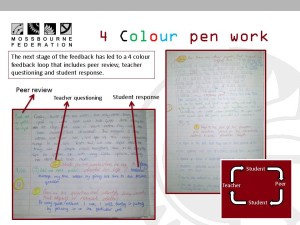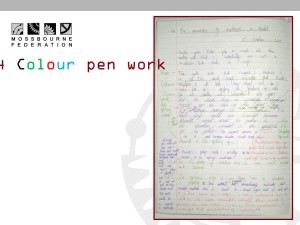12.08.14Spinning Gold From Green Pens
One of the highlights of my recent trip to the UK was the day I got to visit two life-changing schools in a single day: King Solomon Academy and Mossbourne Community Academy. Really, both schools deserve about a week of observation to do them justice but even with such inexcusably short visits it was hard not to be swimming in epiphanies, and the upside of my cheek by jowl visits was that they caused me to think about commonalities. After all, they are very different schools but both with breathtaking academic results (not to mention the presence of humble, wise and dynamic leaders and talented, team-oriented teaching staffs). And, if you will, it’s sort of my job to observe the high performers and note what’s theme and what’s variation.
A Bit of Background
KSA is situated on the western side of London, serving kids in the heavily East Asian communities near Edgeware Road—one of the poorest areas of London. Mossbourne is in Hackney, in East London, also an area with high levels of poverty, though in this case it’s a neighborhood where London’s poor have lived for generations. KSA is small, with 600 or so students spread from 3 to 18 years. It’s also new; it was in the news recently when it’s first round of GCSE results came out (US readers, GCSE or General Certificate of Secondary Education is a series of demanding tests that students in the UK take around age 16 as the gateway to university). 93% of students have achieved 5 passing grades, making the school one of the best in the country. The results were so impressive they were national news though, as Head Teacher Max Haimendorf is often the first to observe, its first round of the assessments for the school, and there’s lots to be done. Mossbourne is about twice as large as KSA and has been around since 2004. It’s been consistently lauded as one of the best inner city schools in England–Its two Ofsted reports judged it to be ‘outstanding’ – in terms of behavior, structure, culture, ICT, parent satisfaction and, academic achievement, and the second judged it ‘amongst the very highest in the country.’ Under Peter Hughes’ able leadership, it annually sends students to England’s top universities and is now replicating.
That said, the schools have much in common—structure and love; high academic and behavioral expectations, and ink.
Pen and Ink: The Power of the (Apparently) Mundane
One of the first things I noticed in common, though, was pens. At both schools there was a system for what color ink students used. They wrote in black. Their teachers commented in red. Students responded to those comments and made revisions in green. Teachers would ask for green pens and every student would have their green pen out working on responding to their teacher’s feedback. And of course, the fact that they responded to each piece was instantly visible because of the ink color. Same system at both schools.
Many of you in the U.K. will say, “Oh we do that. Lots of schools do that in the UK,” but of course what separates the great from the merely good is often the execution of a good idea more than the idea itself. Few use this simple tool with the intentionality, follow through, and power that KSA and Mossbourne do it. I followed up with Peter Hughes of Mossbourne to ask for more details and he passed along a summary of “how they do it” that one of his outstanding teachers, Alex Douglas, put together. Alex is from Yorkshire, trained through Teach First, and is in his 3rd year of teaching. He’s passionate about writing, loves words, and according to Peter, kills it in the classroom. And he’s proudly from Yorkshire. (I think I said that already.)
Anyway his amazing summary, is attached below and it’s going to blow you away—an incredible model of the power thoughtful teachers derive from careful reflection on and application of “simple” tools… often tools that are so simple others might overlook their potential power.
So powerful. Starts simple. Grows legs, adapts and develops and makes a routine of the sort of intellectual work that drives results. Fitting. Increasingly, I see that in great schools academic systems are as important as behavioral ones. Systems acculturate in a consistent way and they make efficient. What better to do that with than what’s most important. I wrote a bit about academic systems in TLaC 2.0, but I’m just getting my heard around how well and extensively great teachers use them so this is one of my first areas for 3.0 expansion.











We are at the beginning stages of trying to implement “green pens” at our school, as in, we just (this week) bought green pens for our students. I’d love to see, or hear, more about using feedback, especially written feedback and extensions in math classes. All the examples I’ve seen on the internet have been for English classes. Trying to break away from the “right or wrong” mentality but having a hard time visualizing the process and getting ideas for extensions.
Thanks, Rebecca. Great question. I will ask for some math teacher insight on facebook etc and share what i get.
Couple of further thoughts, Rebecca, while I wait for math folks to weigh in. The core of what’s powerful to me is what’s simple here. The idea that the color of ink used differentiates three things: original work; teacher comments and student responses to teacher comments. The different colors of ink make it more obvious whether and to what degree students have used feedback. This makes them accountable and because they are accountable makes them more likely to do their best work. There isn’t much there that a math teacher could use. Student does problem in pencil. Teacher makes comments or corrections in one color. These could be challenge questions (can you think of another time you might use this idea? what’s the principle we’re applying here?) or corrections “check your work in the last three steps. The student responds to these comments in “green” or any other visually distinctive format. The notion that feedback gets used and responded to is reinforced and visibly obvious to both teacher and student. That part is where the greatest value is and that seems usable in any content area.
David Thomas one of the Math teachers I follow on twitter responds: For more open-ended tasks you’d use this in exactly the same way! For more traditional questions, still offer feedback and get students to correct work, [but] the dialogue need not be in words.